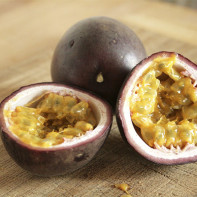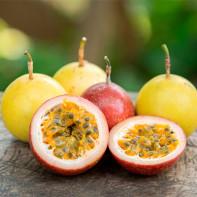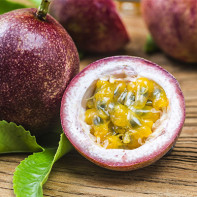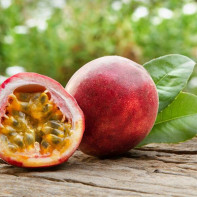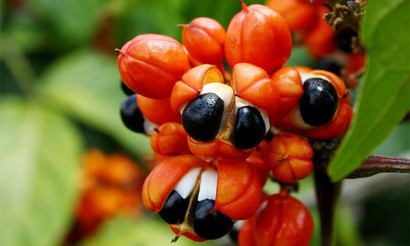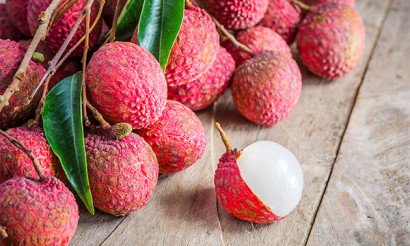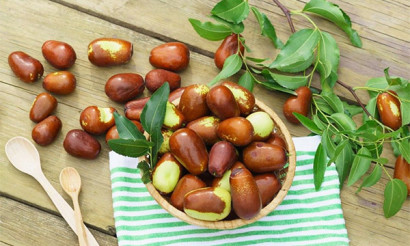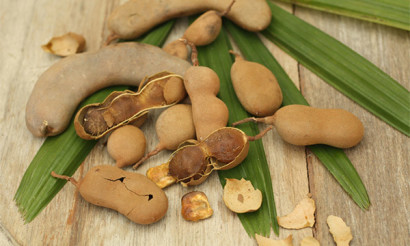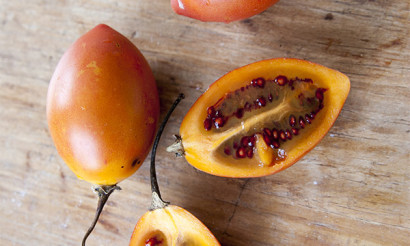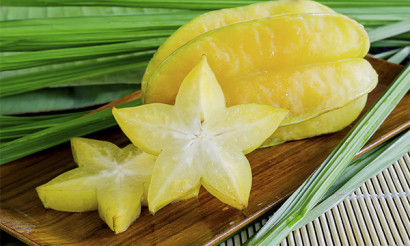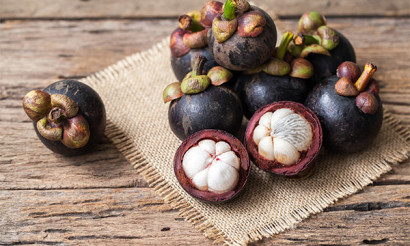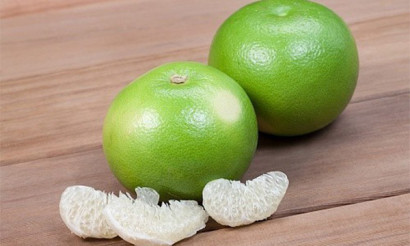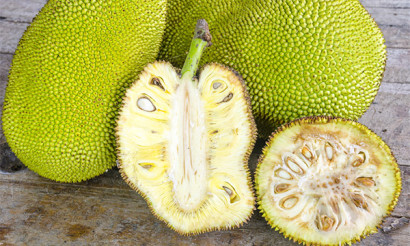Passion fruit: benefits and harms to the body
Passion fruit is a tropical fruit from the Passiflora family, growing on strong vines about 10 meters long. Passion fruit is of several types, on which the size and color of the fruit depends. Many people like the fragrant and tasty fruits, in addition, they are very useful for the human body, so you should include them in your diet as often as possible.
- What does passion fruit look like and where does it grow
- Composition and calorie content
- The beneficial properties of passion fruit
- General benefit
- For women
- For men
- During pregnancy
- When breastfeeding
- For kids
- When losing weight
- Passion Fruit Oil: Properties and Applications
- Application in traditional medicine
- Passion fruit in cosmetology
- For face
- For hair
- Harm and contraindications
- How to choose and store passion fruit
- How to eat passion fruit
- How much can you eat per day
- Can I eat bones
- How to clean
- What can be prepared from passion fruit: recipes
- Jam
- Juice
- Sauce
- Smoothie
- Interesting facts about passion fruit
What does passion fruit look like and where does it grow
Passion fruit is a strong tree creepers up to 10 meters long, on which flowers appear once a year, and after 80 days ripe fruits grow from them. The fruits are similar to large dark purple or yellow plums. Ripe fruits have a slightly wrinkled, dense peel. If the skin is smooth and not strong enough, this indicates the immaturity of the fruit.
There are several varieties, but the most common are yellow and purple. If we talk about purple passion fruit, it is mainly distributed in South America, Africa, Thailand, Australia, but its homeland is Brazil and Argentina. There is no exact data on the origin of yellow passion fruit. It is preferable to take purple directly into food, and yellow fruits are used mainly for industrial purposes.
It should be noted that the largest passion fruit crops are grown in the Hawaiian Islands, where they produce juice from this fruit on an industrial scale. It is also widespread in Kenya, South Africa, India, Sri Lanka and some other countries.
You can grow passion fruit in any country, if at the same time artificially create all the necessary conditions for it. It is able to withstand small frosts, but a significant minus temperature can destroy the plant, which prefers nevertheless warm tropics. This fruit is grown in Russia, and often at home. Passion fruit seeds, which are often known as passiflora, are sold in specialized stores.
Composition and calorie content
Passion fruit is a bright and tasty fruit, which is also very useful for humans. The rich composition of the fruit includes many vitamins (C, A, B vitamins, biotin and folic acid), minerals (potassium, calcium, magnesium, iron, sodium, iodine, zinc, etc.), as well as antioxidants, flavonoids, beta-carotene and, of course, fiber.
Passion fruit is a fairly high-calorie fruit - about 68 kcal per 100 g (many fruits contain no more than 50 kcal per 100 g). But despite this, it can and should be included in the diet of losing weight, as it is able to make up for the lack of vitamins and nutrients, as well as saturate the body with energy and overcome many ailments.
The beneficial properties of passion fruit
General benefit
Passion fruit has a rich vitamin and mineral composition, due to which it is very healthy. Ripe fruits allow you to preserve youth and beauty and, in general, have a positive effect on the body.
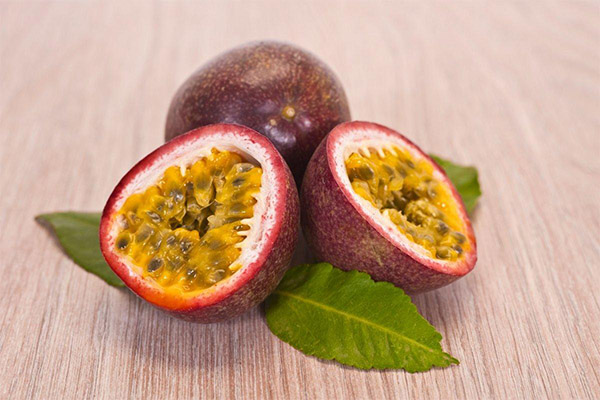
Due to the abundant content of vitamin C, passion fruit is indicated for the use in the season of colds and viral diseases. This fruit is able to enhance immunity and give strength to the body to fight various diseases.
Passion fruit also has a positive effect in cardiovascular diseases, strengthening the walls of blood vessels and regulating cardiac activity.The antioxidants included in the tropical fruit reduce bad cholesterol in the blood, preventing the development of diseases such as stroke, heart attack, diabetes and obesity.
Ripe passion fruit has a mild laxative effect, which helps to overcome constipation. In general, the fetus has a beneficial effect on the entire digestion process, so it should be included in its menu for people suffering from diseases of the stomach and intestines.
Doctors also recommend consuming fresh passion fruit for those who suffer from kidney diseases, gout, asthma, neuropsychiatric disorders, and depression. Passion fruit can also have a calming effect, helping to overcome insomnia.
For women
All women want to stay healthy and beautiful as long as possible. Passion fruit will help prolong your youth and improve the condition of the skin, hair and the body as a whole. Regular consumption of this tropical fruit will only have a positive effect on the female body. Vitamin A improves eyesight, C helps to overcome colds, antioxidants, which are also found in passion fruit in large quantities, eliminate wrinkles and heal the skin, making it smooth and radiant. In addition to direct ingestion, passion fruit can be used as part of scrubs, masks and other home-made cosmetics.
For men
Passion fruit is beneficial for the male body, primarily because it has a beneficial effect on the reproductive system. It is believed that the regular inclusion in the diet of this tropical fruit increases the chances of conception several times. The beneficial effects of passion fruit on the sex life of men are also known.
It is especially useful for men aged 35–45 years who are at risk of developing diseases of the cardiovascular system. The ingredients in this fruit prevent the development of diseases such as heart attack and stroke. The ability of passion fruit to reduce stress, activate the brain and eliminate insomnia has also been proven.
During pregnancy
Pregnant women should consume exotic fruits very carefully and in small quantities. The same restrictions apply to passion fruit. Before you include this fruit in your menu, the expectant mother must make sure that there is no allergy to it. To do this, try a slice of passion fruit and follow the reaction of the body after 2-4 hours. If no manifestations were found, then there is no allergic reaction, so you can safely include passion fruit in your diet.
Passion fruit can eliminate edema that is characteristic of pregnant women, as well as prevent blood pressure spikes, improve digestion and the functioning of the nervous system. Passion fruit is also very useful for an unborn child - it has a beneficial effect on the development of the neural tube of the fetus, as well as on the formation of the bone system, muscles and brain.
When breastfeeding
During breastfeeding, you should be careful about introducing new foods into your diet, especially those that are allergenic. It is advisable for lactating women not to consume passion fruit and other exotic fruits. But if you really want to try this delicacy, you can treat yourself to one piece. In the absence of allergies in the baby, the use of passion fruit is permissible only in small quantities and not every day. Despite the fact that the fetus contains many vitamins and other beneficial substances, it is advisable to wait until the completion of breastfeeding, and only then introduce it into your diet.
For kids
Passion fruit is useful for the child's body, as it has the ability to enhance immunity, saturate with vitamins and other beneficial substances. However, pediatricians do not recommend giving passion fruit to children under the age of three years, since the body of a small child is not yet able to digest fruits with such a complex composition. To introduce fruit into the child’s diet should be gradual, starting with a single slice and bringing to a serving of 100-150 g per day.
When losing weight
In the process of losing weight, it is advisable to consume a lot of vegetables and fruits. Firstly, plant foods contain a sufficient amount of beneficial ingredients that may be lacking in the body, which is in shortage of nutrients. Secondly, passion fruit, which contains a large amount of fiber, is able to stimulate the digestion process, acting as a mild laxative, and also maintain the necessary level of energy in the body for a long time.
In order to achieve maximum results in losing weight, you need to consume passion fruit regularly. It is advisable to eat this fruit in the morning, but not on an empty stomach or snack on it between main meals. There are several options for fasting days and passion fruit diets, but they are quite tough, and therefore suitable only for a completely healthy body and require prior consultation with a doctor.
Passion Fruit Diet
In the diet should be present not only fruits, but also proteins, as well as products containing healthy fats. An approximate passion fruit diet menu looks like this:
- Breakfast: 100–150 g of passion fruit, 100 g of natural yogurt, boiled egg.
- Snacks (lunch and afternoon snack): 100 g passion fruit, 30 g nuts (almonds, hazelnuts, walnuts).
- Lunch: vegetable soup, 100 g of protein product (chicken, fish, beef).
- Dinner: cottage cheese with the addition of live yogurt.
Such a diet is allowed to follow no more than one week and repeat no earlier than a month. The rest of the time it is necessary to eat healthy, mainly plant foods, observing the caloric intake of the diet, the balance of proteins, fats and carbohydrates, as well as dealing with feasible physical activity.
Unloading day on passion fruit
On an unloading day, you can eat only this fruit, eating up to 1 kg of passion fruit per day. At the same time, during the day it is allowed to drink only clean still water and a glass of kefir for dinner. Repeating a fasting day on passion fruit is allowed no more than once a week. The effect of weight loss will be noticeable the next morning, which is explained not only by a calorie deficit, but also by the ability of this tropical fruit to remove excess fluid from the body and stimulate digestion. It is important not to eat too much fruit, as this can lead to digestive upsets like diarrhea, as well as nausea and headaches.
Passion Fruit Oil: Properties and Applications
Passion fruit oil is a valuable product in cosmetology. It helps in the fight against early aging, and also moisturizes, nourishes the skin and has an anti-inflammatory effect. Oil also helps in the fight against cellulite, and can also be used when performing sports massage (to overcome the symptoms of sprains). Passion fruit oil contains a large amount of bioflavonoids, carotenoids, unsaturated fatty acids, vitamins A, C, K, E, as well as calcium, potassium and phosphorus.

Cosmetic passion fruit oil can be used in daily care of the skin of the face and body, as well as hair and nails. However, it is necessary to choose a really high-quality oil in order to get all the beneficial properties from it.
Apply oil to the skin of the face by lightly driving in the fingertips. Remove excess oil with a napkin, but do not rinse the entire product. For hair, you can make masks based on passion fruit with the addition of other vegetable oils - coconut, linseed, burdock. Warm the mixture in a water bath, apply to hair from roots to ends, hold for half an hour (as long as possible) and rinse. To strengthen nails, you can use passion fruit oil, applying it in a small amount to clean, unpainted nails before bedtime.
Application in traditional medicine
Passion fruit is not only a delicious fruit, but also healthy. Due to its rich composition, it is used in many recipes of traditional medicine. Moreover, not only the pulp of the fruits itself has healing properties, but also their peel, as well as the leaves and bark of the stems.
The pulp of fruits is recommended to be used fresh with gout and rheumatism, as it can quickly relieve pain.Also, passion fruit is recommended for people suffering from constipation and fluid retention in the body, because this fruit has a mild laxative property and quickly removes excess water.
From the leaves of passion fruit, a medicine is prepared that helps with insomnia and nervous disorders. Also, an extract from the leaves is indicated for bruises, pain for menstruation and other pain symptoms. The listed properties of passion fruit leaves are explained by the high content of passiflorin, a well-known painkiller and sedative, in them.
From the peel, you can get the necessary amount of vitamin C, which the body especially needs during the spread of colds and viral diseases. And the antioxidants contained in passion fruit prevent early aging of the body and even the development of cancer.
Passion fruit in cosmetology
Since ancient times, passion fruit has been used in recipes for beauty and youth. Due to its rich composition, this fruit is able to have a beneficial effect on the whole body. Fruit extract is used in traditional cosmetology and in folk beauty recipes. Women from generation to generation pass on the secrets of youth and beauty in which passion fruit is present. Consider the most interesting of them.
For face
- Tightening mask. For its preparation, you need to take 2 tbsp. passion fruit pulp, 2 tbsp. banana puree, 1 tbsp. starch, 1 tbsp almond oil. Mix all ingredients, apply on face, hold for 20-30 minutes, then rinse with warm water. Such a mask with regular use (from 7 to 10 days, every other day) will make the face contour more clear, reduce wrinkles and generally refresh the skin.
- A “refreshing” mask will transform your face after several sessions. It’s easy to cook it: you need to take 3 tbsp. passion fruit pulp, 1 tbsp. avocado, 1 tsp. oatmeal and honey, combine all the components (you can use a blender), apply to the face and leave for 30 minutes, then rinse. The components included in the mask can eliminate sagging and puffiness, strengthen thin capillaries, make the skin more elastic and fresh.
- Nourishing mask that prolongs youthful skin: 1 tsp. mix passion fruit and cocoa powder with one yolk and two pinches of dried leaves of plantain. Apply the resulting composition to the skin of the face with massaging movements, leave for half an hour and rinse. A nourishing mask will help not only return the skin to a flowering appearance, but also reduce the appearance of inflammation, acne and black spots.
- A mask for cleansing the face is prepared as follows: 2 tbsp. mix passion fruit puree with 1 tsp. sage and 1 tsp henna. Apply the resulting composition to the face, rinse after 8-10 minutes. It is important not to hold this mask for too long to prevent irritation, since it does not contain the mildest substances - sage and henna. Repeat this mask once a week. Significant improvements will be noticeable after the first procedure.
For hair
Passion fruit oil works best on hair. It must be applied to the ends of the hair in a small amount or make masks based on it. One of the mask options: in equal proportions (depending on the thickness and length of the hair, take the appropriate amount of ingredients) mix passion fruit oil, coconut and burdock oil, heat the composition in a water bath to a warm but not hot condition, hold for an hour, then rinse. The mask will make ringlets more vibrant and shiny, as well as strengthen them and protect against damage.
A passion fruit nourishing mask is prepared as follows: 2 tbsp. mix pulp with 1 tbsp. natural yogurt, one yolk and apply to the hair along the entire length. If necessary, the volume of ingredients can be increased. Keep this mask for 30 minutes, then rinse. This composition perfectly nourishes the hair, makes it more healthy, soft and shiny.
Hair mask “moisturizing”: 2 tbsp. Passion fruit pulp mixed with 1 tbsp. burdock oil and one yolk. Apply the composition to the hair, hold for half an hour and rinse thoroughly.After the first application, the effect will be noticeable - the hair will look more healthy, moisturized and radiant.
Harm and contraindications
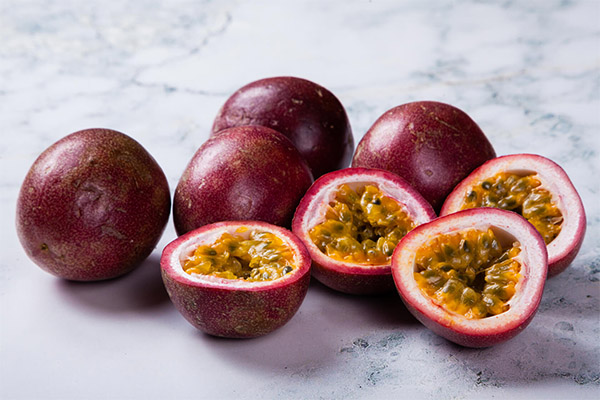
Passion fruit is an allergenic product, like most exotic fruits. It must be consumed in small quantities to avoid the occurrence of allergies and negative reactions of the body. Overeating these fruits threatens indigestion, discomfort in the abdomen, and also an increase in body weight, as passion fruit contains a large amount of sugars.
Passion fruit is contraindicated in the following cases:
- individual intolerance;
- diseases of the digestive system in the acute stage;
- gastritis and stomach ulcer (after consultation with a doctor).
It is also important to know that before consuming passion fruit you need to make sure its quality. Fruits should not be wrinkled or have any defects, scratches, etc. The skin may contain harmful substances, since for longer storage the fruit is treated with a special wax composition. Therefore, before you eat passion fruit, you must thoroughly wash it with soap and pour over boiling water.
How to choose and store passion fruit
When choosing really healthy and tasty fruits of passion fruit, you need to use some tips:
- The peel of a quality fruit is resilient, slightly rough and uniform in color. Any spots and cracks will indicate damage in which it is undesirable to eat such fruits.
- The weight of one fruit should be heavy (about 100 g). Poor-quality fruits may seem too light, which means their flesh has dried over time.
- If you shake the fruit, it will make a characteristic “gurgling” sound, which indicates that the flesh of passion fruit will be juicy and tasty.
- Purple passion fruit is sweeter than yellow. There are also several varieties that are very acidic and are used in cooking instead of lemon. Sweet fruits have a rough, wrinkled peel, and sour ones have a smooth and even.
If you could not choose a ripe fruit, you can correct the situation by putting the unripe fruit in a vase at room temperature. In a few days, the fruit will ripen and become aromatic and delicious. Ripe passion fruit is stored in the refrigerator at a temperature of 1 degree and for a short time - no more than 7 days.
If you can’t eat the entire supply of tropical fruit, you do not need to wait until it deteriorates. You can save passion fruit by freezing its pulp, mixed with a small amount of sugar. In this form, it is stored in the freezer for about a year.
How to eat passion fruit
Tasty and ripe fruits can be eaten just like that, it is not necessary to cook certain dishes. To do this, you must first thoroughly wash the fruit, cut in half and eat with a spoon. You can eat pulp, juice and passion fruit seeds in food, but the peel and white part must be discarded.
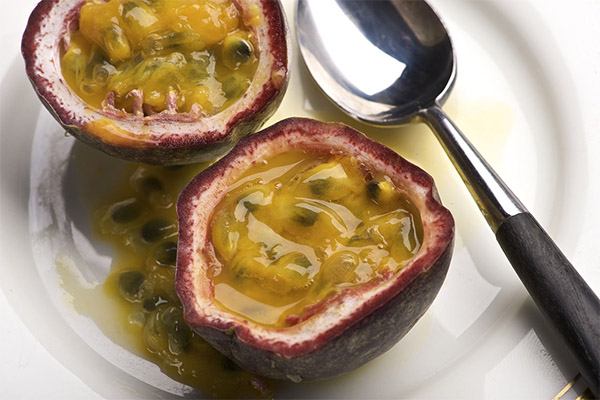
How much can you eat per day
Passion fruit can be consumed every day, but in a limited quantity - a maximum of 300 g. Exceeding this amount threatens the appearance of allergies and such side effects as nausea, indigestion and headaches. It is also advisable to eat this fruit after the main meal, as a dessert or for a snack.
Can I eat bones
Passion fruit bones can and should be eaten together with pulp, as they have a number of useful properties for the body: they stimulate digestion, saturate with vitamins and minerals, and help overcome a number of diseases. You need to use the bones, carefully chewing them. By taste and texture, they can resemble grapevines, however, they are similar in composition.
How to clean
Peeling passion fruit is simple enough, but first you need to wash the fruit with hot water to remove the wax layer that covers the fruit for longer storage. Already clean and dried fruit can be cut in half with a knife and eaten. It is important to use only a sharp knife, since the soft flesh of passion fruit can simply be crushed.
What can be prepared from passion fruit: recipes
Passion fruit can be consumed both fresh and to prepare various dishes from it.In Thailand, many consume this fruit, sprinkled with salt and black pepper, in the Philippines - hot red. These eating habits are for true gourmets, but there are more classic recipes for passion fruit dishes.
Jam
If the traditional jam from strawberries, cherries, apples and other berries and fruits is already quite tired and fed up, you can try to cook it from such an exotic as passion fruit. To prepare it, you need to take 2 kg of pulp of this fruit and 1 kg of sugar. Mix the pulp with sugar and put on low heat, let it boil, keep it on low heat for 15 minutes, then remove and put it back on the stove after complete cooling. The second time the jam is boiled for another 15 minutes, while removing the resulting foam, then cool, put in containers and store in the refrigerator. If long-term storage of jam is planned, the containers must first be sterilized and dried.
Juice
To make freshly squeezed passion fruit juice, you need 5 ripe fruits, some sugar, cold water and ice to serve. Remove the pulp from the fruit with a teaspoon, cutting them in half. Fold the pulp into a blender, add water in a ratio of 1: 3, beat for a couple of seconds. Prolonged beating can lead to grinding seeds and turning them into sand. Then strain the juice through a sieve, add sugar, pour into glasses and put a few pieces of ice. You can add a different amount of water and sugar, depending on individual preferences.
Sauce
For fish or meat, you can cook an unusual exotic passion fruit sauce. This sauce also goes well with rice and can be used as an additive to almost any dish.
Recipe: knead the pulp of 2 fruits of passion fruit, dilute with a small amount of water, strain through a sieve to remove seeds. Sauté the onion in a small amount of butter, add 5–6 finely chopped sprigs of parsley or thyme. Mix all this with passion fruit pulp, add salt and pepper to taste, then simmer over low heat for 15 minutes and serve hot in the main dish.
Smoothie
From passion fruit, you get a delicious and nutritious smoothie. You can cook it according to the following recipe: pulp of two fruits, 100 ml of orange juice, 10 ml of lime and ginger juice, 40 ml of sugar syrup and a sprig of mint mixed with a blender, pour into glasses, garnish with passion fruit slices and serve. You can add ice cubes to the smoothie, on a hot summer day this drink will be very handy.
Interesting facts about passion fruit
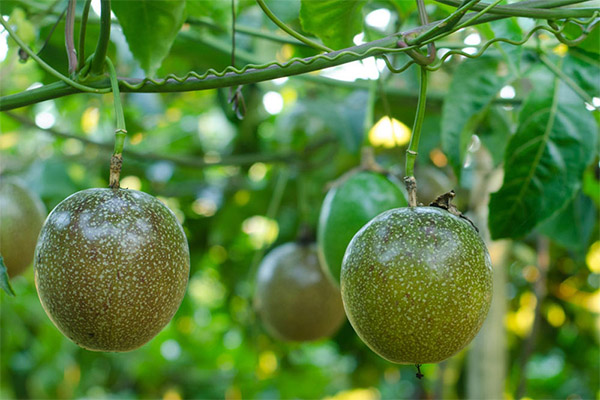
- The name of the fruit comes from the Indian "passion fruit", meaning "food in a bowl." This means that the fruit can be eaten from a bowl by taking out its flesh.
- Passion fruit is often called the “fruit of passion”, since in the 16th century this fruit became a symbol of the crucifixion of Jesus Christ.
- In some countries, passion fruit is eaten exclusively salted and pepper, and they also prepare sauces and additives for meat and fish dishes from it.
- Passion fruit contains antioxidants that have the ability to destroy pathogens of serious diseases, including cancer.
- Passion fruit, although it is a tropical plant quite demanding of climatic conditions, can be grown at home. To do this, place the seedlings in a bright room with a temperature of 12 to 25 degrees Celsius. The plant will not only be a decorative decoration at home, but can also bear fruit with proper care.
- The sweetest fruits have a rough, wrinkled surface, but a smooth, even skin indicates that the fruit has not yet ripened or belongs to an acidic variety.
«Important: all information on the site is provided exclusively in fact-finding purposes. Before applying any recommendations, consult with a profile specialist. Neither the editors nor the authors are liable for any possible harm caused materials. "


